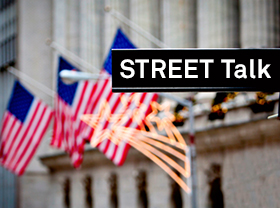S&P Global Offerings
Featured Topics
Featured Products
Events
S&P Global Offerings
Featured Topics
Featured Products
Events
S&P Global Offerings
Featured Topics
Featured Products
Events
Banking & Capital Markets
Economy & Finance
Energy Transition & Sustainability
Technology & Innovation
Podcasts & Newsletters
Banking & Capital Markets
Economy & Finance
Energy Transition & Sustainability
Technology & Innovation
Podcasts & Newsletters
S&P Global Offerings
Featured Topics
Featured Products
Events
04 Feb, 2025
"Street Talk" is a podcast hosted by S&P Global Market Intelligence that takes a deep dive into issues facing financial institutions and the investment community.
Listen on
The bank advisory community is optimistic about the outlook for bank M&A activity, and they should be, according to Mercer Capital managing director Jeff Davis.
In the latest "Street Talk" podcast, Davis discussed his takeaways from the annual Acquire or Be Acquired Conference, held Jan. 26–28, where scores of advisers shared their viewed for M&A activity to be materially stronger this year. Davis also discussed the improving fundamental environment for banks, the outlook for bank valuations and whether institutions should take advantage of the current optionality in the marketplace and pursue capital raises or acquisitions while the window remains open.
Davis said bankers and advisers in attendance at the conference expressed an enthusiastic outlook for the banking sector and M&A activity. He described the sentiment as the "most optimistic" that he can remember since 2017 or 2018, which was close to the peak of the last M&A cycle, due to improving fundamentals, higher valuations and expectations for a more favorable regulatory environment.
"The adviser community is optimistic and should be," Davis said. "It's a very good setup. And we'll see how it plays out, but it's the best setup we've had since probably 2017 or 2018."
Optimism has returned after several years of depressed bank deal activity. The banking industry had its earnings contract in 2022, 2023 and the first nine months of 2024, but the future looks brighter. Davis pointed to the positive earnings forecast of the KBW research team that the firm's president and CEO, Tom Michaud, shared at the event. KBW sees EPS rising by 6% in 2025 and 12% in 2026, and Davis said higher earnings serve as "the mother's milk for share performance."
The earnings growth should benefit both buyers, who have improved acquisition currencies, and sellers, whose earnings outlook is also improving. Banks are poised to report stronger net interest margins as their cost of funds eases, while fixed-rate assets purchased or originated in 2020 and 2021, when rates were low, move off institutions' books and are replaced with higher-yielding assets.
However, the presence of those lower-yielding assets on many banks' books still serve as a "fly in the ointment" to deals for now. Buyers must mark target's balance sheets to market when a deal close, and those marks have been punitive over the past few years. Davis noted that these marks are less punitive than they were a year ago, but the potential for rising rates could complicate matters. Davis warned that if inflation trends upward, it could negatively impact deal activity and stock prices, making negotiations more challenging.
Still, Davis noted that the capital markets are open and new funds are often needed to support deals since regulators expect capital levels at the pro forma institution to be at a certain minimum the first day after a deal closes.
While regulators remain focused on the capital levels, many presenters at the event touted the prospect of a friendlier regulatory environment to bank deals. Advisers believed that the timeline for regulatory approval for deals under the Trump administration should be faster than under the Biden administration.
Some companies might want to act while the window is open. For instance, Davis said that if a PNC Financial Services Group Inc. or U.S. Bancorp wanted to pursue an acquisition of Truist Financial Corp., Regions Financial Corp., First Horizon Corp. or another franchise, there is a limited window of time for such a transaction. He noted that the Trump administration will place new heads at the bank regulatory agencies that are expected to "much more agreeable to M&A," but it will take some time to put those leaders in place and then take another six to nine months to enact policy changes. That leaves a relatively short period of time where larger banks have some certainty that they could pursue deals.
"The larger you are, the tighter the window is. That's less true for small institutions who want to do M&A, really, it's more about the backdrop is good with access to capital and stock price is up," Davis said.


